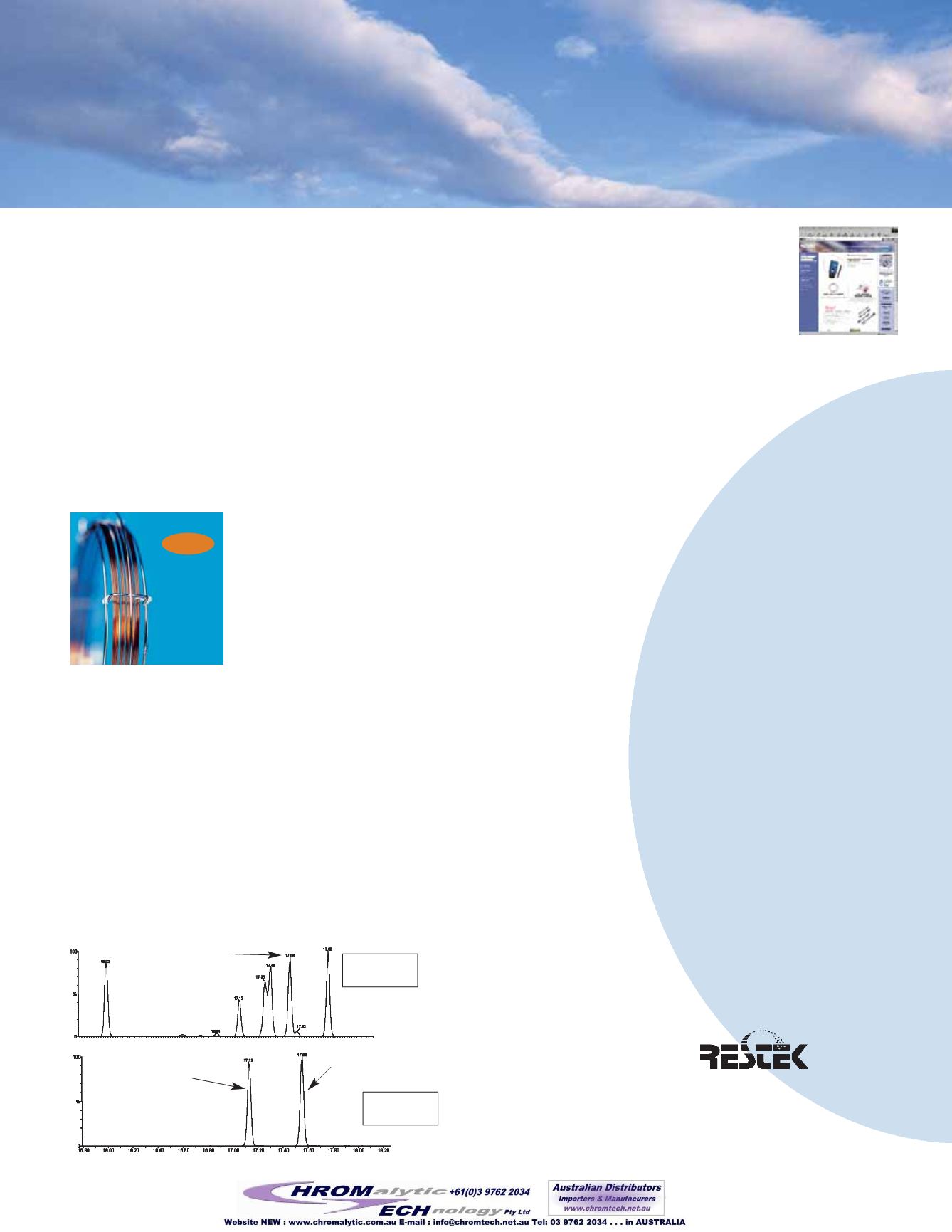

High Resolution GC/MS Separations of
Dioxin and Furan Congeners
Using Restek's New Rtx
®
-Dioxin2 Capillary GC Column
the
www.restekcorp.com2003
vol. 4
Advantage
Innovators of High Resolution
Chromatography Products
in this issue
Dioxin and Furan
Congeners GC/MS Analysis
Pg. 1–2
Chlorophenoxyacid
Herbicides HPLC Analysis
Pg. 3,5
Extracolumn Volume and its Effects in
Gradient HPLC
Pg. 4–5
Replacement Parts for HPLC Systems
Pg. 6–7
Faster GC Analysis of Purgeable Organics
Pg. 8–9
New Reference Materials for Forensic and
Environmental Analyses
Pg. 10
Bulk HPLC Silica and Bonded
Phase Packings
Pg. 11
Peak Performers—Avoid Septum
Problems
Pg. 12–13
Cool Tools—Super-Clean
™
Gas
Filters
Pg. 14–15
By Frank Dorman, Ph.D., Director of Technical Development
✔
Resolves 2,3,7,8-substituted congeners from each other and from non-toxic congeners.
✔
Resolves furan congeners from chlorodiphenyl ethers.
✔
Stable to 320ºC, for longer column life.
An accurate GC analysis of dioxin and furan con-
geners is a challenge. Separation of the toxic con-
geners (configurations with substitutions at the 2, 3,
7, and 8 positions) from the non-toxic congeners is
difficult on
almost any sta-
tionary phase.
Most laborato-
ries perform an
initial analysis
using a 5%
diphenyl / 95%
dimethyl poly-
siloxane col-
umn (e.g.,
Rtx
®
-5) to
obtain reasonable estimates of concentrations for the
2,3,7,8-substituted congeners. For some of the target
congeners, this quantitation is biased toward high
values, due to coelution with non-toxic congeners.
As many as five non-toxic TCDFs can coelute with
2,3,7,8-tetrachlorodibenzofuran, for example, in an
analysis on a 5% diphenyl / 95% dimethyl polysilox-
ane (5-type) column.
Because of this coelution issue, many laboratories
use confirmation columns, most commonly high
cyanopropyl (225-type) stationary phases (e.g.,
Rtx
®
-225, Rtx
®
-2330), in order to more accurately
quantify the toxic congeners. Unfortunately,
cyanopropyl columns exhibit poor thermal stability,
and therefore column lifetimes are short.
Since most methods for analysis of dioxins and
furans include extensive sample extract cleanup, and
high-resolution mass spectrometry, a primary
requirement of the ideal analytical column is com-
plete separation of the toxic dioxin and furan con-
geners from each other. Additionally, it is desirable
for the column to have high thermal stability and
long lifetime.
With these characteristics in mind, Restek chemists
developed Rtx
®
-Dioxin2 capillary GC columns. These
new columns completely resolve the 2,3,7,8- substi-
tuted congeners from each other, and from the non-
toxic congeners as well. Figure 1 shows the separa-
tion of the tetrachlorodibenzodioxins on a 60m x
0.25mm ID x 0.25µm Rtx
®
-Dioxin2 column. 2,3,7,8-
TCDD is well resolved from the other congeners in
this group and can be quantified accurately. The col-
umn also is available in an alternative format com-
monly used for this analysis: 40m x 0.18mm ID x
0.18µm. Either column is stable to 320ºC.
We’ve
expanded
our web site!
• New Features.
• Fast searches.
• Easy navigation.
We welcome
your visit.
www.restekcorp.comFigure 1
—2,3,7,8-Tetrachlorodibenzodioxin can be resolved from other TCDD congeners by using
an Rtx®-Dioxin2 column.
60m, 0.25mm ID, 0.25µm Rtx
®
-Dioxin2
(cat.# 10758)
Oven temp.:
130°C (hold 1 min.) to
205°C @ 45°C/min. to 305°C @
6°C/min. (hold 30 min.);
Dead time:
2.89 min.;
Carrier gas:
helium at
1.5mL/min., constant flow
Chromatogram courtesy of Karen MacPherson and Eric Reiner, Ontario Ministry of the Environment, Etobicoke, Ontario, Canada.
Native TCDDs
321.8936 m/z
1,2,3,4-TCDD-C13
2,3,7,8-TCDD-C13
C13 labels
331.9386 m/z
GC_EV00702
Res tek
Exclusive
!
new
2,3,7,8-TCDD


















